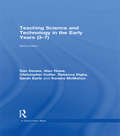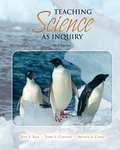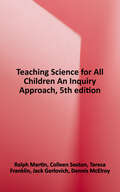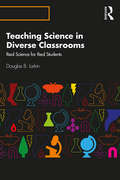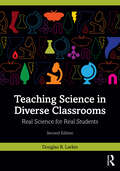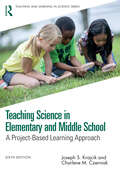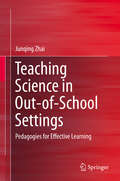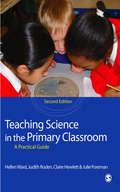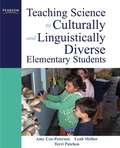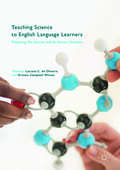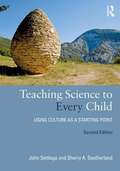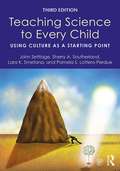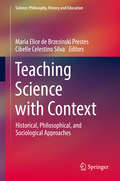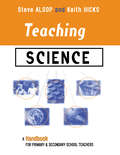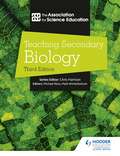- Table View
- List View
Teaching Science and Investigating Environmental Issues with Geospatial Technology
by Michael Barnett Nancy Trautmann James MakinsterThe emerging field of using geospatial technology to teach science and environmental education presents an excellent opportunity to discover the ways in which educators use research-grounded pedagogical commitments in combination with their practical experiences to design and implement effective teacher professional development projects. Often missing from the literature are in-depth, explicit discussions of why and how educators choose to provide certain experiences and resources for the teachers with whom they work, and the resulting outcomes. The first half of this book will enable science and environmental educators to share the nature and structure of large scale professional development projects while discussing the theoretical commitments that undergird their work. Many chapters will include temporal aspects that present the ways in which projects change over time in response to evaluative research and practical experience. In the second half of the book, faculty and others whose focus is on national and international scales will share the ways in which they are working to meet the growing needs of teachers across the globe to incorporate geospatial technology into their science teaching. These efforts reflect the ongoing conversations in science education, geography, and the geospatial industry in ways that embody the opportunities and challenges inherent to this field. This edited book will serve to define the field of teacher professional development for teaching science using geospatial technology. As such, it will identify short term and long term objectives for science, environmental, and geography educators involved in these efforts. As a result, this book will provide a framework for future projects and research in this exciting and growing field.
Teaching Science and Technology in the Early Years (3–7)
by Christopher Collier Dan Davies Alan Howe Sarah Earle Kendra McMahon Rebecca DigbyTeaching Science and Technology in the Early Years (3-7) celebrates young children’s amazing capabilities as scientists, designers and technologists. Research-based yet practical and accessible, it demonstrates how scientific, designing and making activities are natural to young children, and have the potential for contributing to all aspects of their learning. By identifying the scientific and design-related concepts, skills and activities being developed, the book enables the reader to make more focused diagnostic observations of young children and plan for how they can help move them forward in their learning. This second edition has been thoroughly updated and features: Six new chapters providing practical advice and examples for enhancing scientific and technological learning through thematic approaches a new chapter focusing on the outdoor learning environment and how this can support science and technology new case studies of successful early years practice, alongside examples of practical planning for learning, and advice on documenting children’s learning stories, guidance on the role of talk, narrative, documentation and planning in relation to early years science and technology Based on the latest research and the first hand experience, this practical and accessible book is essential reading for early years and primary students on undergraduate and Masters level courses. ? ? ?
Teaching Science and Technology in the Early Years (3–7)
by Christopher Collier Dan Davies Alan Howe Sarah Earle Kendra McMahon Rebecca DigbyTeaching Science and Technology in the Early Years (3–7) celebrates young children’s amazing capabilities as scientists, designers and technologists. Research-based yet practical and accessible, it demonstrates how scientific designing and making activities are natural to young children, and have the potential for contributing to all aspects of their learning. By identifying the scientific and technological concepts, skills and activities being developed, the book enables the reader to make more focused diagnostic observations of young children and plan for how they can help move them forward in their learning. This third edition has been thoroughly updated and features: fresh insights into young children’s learning from neuroscience and ‘new-materialist’ perspectives; a UK-wide perspective on Early Years curricula and how they support the inclusion of science and technology as an entitlement for young children; new case studies of successful, evidence-based Early Years practice, alongside new examples of practical planning for learning, and advice on documenting children’s learning stories; an updated chapter on assessing and documenting children’s learning, drawing upon findings from the Teacher Assessment in Primary Science (TAPS) project at Bath Spa University. Based on the latest research and first-hand experience, this practical and accessible book is essential reading for Early Years and Primary students on undergraduate, PGCE and Masters-level courses.
Teaching Science as Inquiry
by Terry L. Contant Arthur A. Carin Joel E. BassResearch tells us that an inquiry approach to science teaching motivates and engages every type of student, helping them understand science's relevance to their lives, as well as the nature of science itself. Teaching Science as Inquiry demonstrates a manageable way for new and experienced teachers to bring inquiry successfully into the science classroom through a 2-part structure: Methods for Teaching Science as Inquiry and Activities for Teaching Science as Inquiry. The Methods portion scaffolds concepts and illustrates instructional models to help readers understand the inquiry approach to teaching. The Activities portion follows the 5-E model (Engage, Explore, Explain, Elaborate, Evaluate), a Learning Cycle model introduced in the methods chapters that reflects the NSES Science as Inquiry Standards. With a new theme of "accountable inquiry," this leading methods text has a renewed focus on assessment (focusing on backwards planning, aligning objectives with assessments, and how to develop understanding of concepts that appear on standardized tests throughout the process of inquiry).
Teaching Science for All Children: An Inquiry Approach, Fifth edition
by Colleen Sexton Ralph Martin Teresa Franklin Jack Gerlovich Dennis McElroyThe Fifth Edition of this popular elementary science methods text emphasizes learning science through inquiry, implementation of the Learning Cycle, NSE standards, constructivism, technology, and strategies for teaching diverse learners. Teaching Science for All Children employs an inquiry model throughout, especially apparent in the design of its learning cycle lesson plans.
Teaching Science in Diverse Classrooms: Real Science for Real Students
by Douglas B. LarkinAs a distinctive voice in science education writing, Douglas Larkin provides a fresh perspective for science teachers who work to make real science accessible to all K-12 students. Through compelling anecdotes and vignettes, this book draws deeply on research to present a vision of successful and inspiring science teaching that builds upon the prior knowledge, experiences, and interests of students. With empathy for the challenges faced by contemporary science teachers, Teaching Science in Diverse Classrooms encourages teachers to embrace the intellectual task of engaging their students in learning science, and offers an abundance of examples of what high-quality science teaching for all students looks like. Divided into three sections, this book is a connected set of chapters around the central idea that the decisions made by good science teachers help light the way for their students along both familiar and unfamiliar pathways to understanding. The book addresses topics and issues that occur in the daily lives and career arcs of science teachers such as: • Aiming for culturally relevant science teaching • Eliciting and working with students’ ideas • Introducing discussion and debate • Reshaping school science with scientific practices • Viewing science teachers as science learners Grounded in the Next Generation Science Standards (NGSS), this is a perfect supplementary resource for both preservice and inservice teachers and teacher educators that addresses the intellectual challenges of teaching science in contemporary classrooms and models how to enact effective, reform
Teaching Science in Diverse Classrooms: Real Science for Real Students
by Douglas B. LarkinAs a distinctive voice in science education writing, Douglas B. Larkin provides a fresh perspective for science teachers working to make real science accessible to all K-12 students. Through compelling anecdotes and vignettes, this book draws on research to present a vision of successful and inspiring science teaching that builds upon the prior knowledge, experiences, and interests of students. With empathy for the challenges faced by contemporary science teachers, Teaching Science in Diverse Classrooms encourages teachers to embrace the intellectual task of engaging their students in learning science and offers an abundance of examples of what high-quality science teaching for all students can look like. This updated and expanded second edition includes more attention to teaching and learning science in a world changed by the pandemic and reaffirms the importance of attending to equity and justice in science classrooms.Divided into four sections, this book centers around the idea that the decisions made by good science teachers help light the way for their students along both familiar and unfamiliar pathways to understanding. The book addresses topics and issues that occur in the daily lives and career arcs of science teachers, such as: Aiming for culturally relevant science teaching Eliciting and working with students’ ideas Reshaping school science with scientific practices Viewing science teachers as science learners Teaching science in turbulent times Grounded in the Next Generation Science Standards (NGSS), this is a perfect resource for both pre-service and in-service teachers and teacher educators that addresses the intellectual challenges of teaching science in contemporary classrooms and models how to enact effective, reform-based science teaching practices for all students.
Teaching Science in Elementary and Middle School: A Cognitive and Cultural Approach
by Dr Cory A. Buxton Dr Eugene F. ProvenzoA practical methods text that prepares teachers to engage their students in rich science learning experiences Featuring an increased emphasis on the way today's changing science and technology is shaping our culture, this Second Edition of Teaching Science in Elementary and Middle School provides pre- and in-service teachers with an introduction to basic science concepts and methods of science instruction, as well as practical strategies for the classroom. Throughout the book, the authors help readers learn to think like scientists and better understand the role of science in our day-to-day lives and in the history of Western culture. Part II features 100 key experiments that demonstrate the connection between content knowledge and effective inquiry-based pedagogy. The Second Edition is updated throughout and includes new coverage of applying multiple intelligences to the teaching and learning of science, creating safe spaces for scientific experimentation, using today's rapidly changing online technologies, and more.New to This Edition:Links to national content standards for Mathematics, Language Arts, and Social Studies help readers plan for teaching across the content areas.Discussions of federal legislation, including No Child Left Behind and Race To The Top, demonstrate legislation's influence on classroom science teaching.New "Scientists Then and Now" biographies provide practical examples of how great scientists balance a focus on content knowledge with a focus on exploring new ways to ask and answer questions.Sixteen additional video demonstrations on the Instructor Teaching Site and Student Study Site illustrate how to arrange and implement selected experiments.
Teaching Science in Elementary and Middle School: A Project-Based Learning Approach
by Joseph S. Krajcik Charlene M. CzerniakTeaching Science in Elementary and Middle School integrates principles of learning and motivation with practical teaching ideas for implementing them. Paralleling what scientists do, project-based learning (PBL) represents the essence of inquiry and the nature of science, and engages children and teachers in investigating meaningful, real-world questions about the world around them. This text provides concrete strategies on teaching using a project-based approach and on meeting the principles in A Framework for K–12 Science Education and the Next Generation Science Standards (NGSS). Features include strategies for planning long-term, interdisciplinary, student-centered units; scenarios to help readers situate new experiences; and a wealth of supplementary material on the Companion Website. Features in the Fifth Edition: Integrates research-based findings from the National Research Council’s Taking Science to School, A Framework for K–12 Science Education, and NGSS to engage learners and help them make sense of phenomena in using disciplinary core ideas, science and engineering practices, and crosscutting concepts Gives attention to cultural diversity throughout the chapters, with an added focus on working with English Language Learners Describes how to develop and use assessments that require students to make use of their knowledge to solve problems or explain phenomena Illustrates how to use PBL to make connections to Common Core Standards for Mathematics and English Language Arts Provides examples of project-based lessons and projects to illustrate how teachers can support children in engaging in scientific and engineering practices, such as asking questions, designing investigations, constructing models and developing evidence-based explanation
Teaching Science in Elementary and Middle School: A Project-Based Learning Approach (Teaching and Learning in Science Series)
by Joseph S. Krajcik Charlene M. CzerniakThis essential science methods resource integrates principles of learning and motivation with practical teaching ideas for the elementary and middle school science classroom. It employs project-based learning (PBL) to enable educators to engage their students in meaningful, real-world questioning about the world. It provides concrete strategies for meeting the Framework for K–12 Science Education. Chapters offer examples of project-based lessons to help teachers support children in varying modes of inquiry, such as asking critical questions, designing investigations, constructing models, and developing evidence-based explanations.Features in the Sixth Edition include: Instruction on using PBL to make connections to Common Core Standards for Mathematics and English Language Arts An increased attention to assessment for learning A focus on three-dimensional learning. This book is ideal for pre-service and in-service elementary and middle school science and STEM teachers and is designed for use in related methods courses or professional learning opportunities.
Teaching Science in Out-of-School Settings
by Junqing ZhaiThis book explores pedagogical approaches used by informal science educators and botanic garden educators in particular, when teaching science to visiting students (7-12 years old). More specifically, it draws on the sociocultural perspective of learning, and highlights the importance of discourse in learning processes. It examines the interactions between four botanic garden educators (BGEs) and their students, focusing on how the students' contributions to the talk are followed up on by the BGEs. Moreover, it includes an investigation into which kinds of teaching behaviours on the part of BGEs can best support learning.
Teaching Science in the Block
by Alvin Pettus Myron BlosserThis book provides detailed instructional strategies, sample lesson plans, and sample assessments to help science teachers make the best us of the additional time available in a block schedule.
Teaching Science in the Primary Classroom
by Hellen Ward Judith RodenWho was right about gravity - Aristotle or Galileo? Do woodlice like the damp or the sunshine? Now in full colour, the new edition of this core textbook is packed full of exciting ideas and methods to help trainees and teachers looking for creative ways of teaching science to primary school children. It's the perfect step-by-step guide for anyone teaching science for the first time. Reflecting the new curriculum, the third edition has been extensively updated throughout and now includes: · a brand new chapter on teaching science outdoors · lots of guidance on how to work scientifically in the classroom · a new focus on assessment of ‘secondary readiness’ · new activities and case studies, with helpful links to developing scientific skills With practical examples, case studies, clear guidance on how to turn theory into creative practice, and lots of ideas for lively science lessons and activities, this is the ideal book for anyone studying primary science on initial teacher education courses, and teachers looking for new ideas to use in the classroom.
Teaching Science in the Primary Classroom
by Hellen Ward Judith RodenWho was right about gravity - Aristotle or Galileo? Do woodlice like the damp or the sunshine? Now in full colour, the new edition of this core textbook is packed full of exciting ideas and methods to help trainees and teachers looking for creative ways of teaching science to primary school children. It′s the perfect step-by-step guide for anyone teaching science for the first time. Reflecting the new curriculum, the third edition has been extensively updated throughout and now includes: · a brand new chapter on teaching science outdoors · lots of guidance on how to work scientifically in the classroom · a new focus on assessment of ‘secondary readiness’ · new activities and case studies, with helpful links to developing scientific skills With practical examples, case studies, clear guidance on how to turn theory into creative practice, and lots of ideas for lively science lessons and activities, this is the ideal book for anyone studying primary science on initial teacher education courses, and teachers looking for new ideas to use in the classroom.
Teaching Science in the Primary Classroom
by Julie Foreman Miss Claire Hewlett Ms Judith Roden Ms Hellen WardThis exciting new edition of a popular book offers the reader the following new elements: - explicit advice on how to link science to cross-curricular learning - updated advice on planning and assessment - guidance on how to accommodate personalised learning within science - more on games to use in science - more on creativity - more on questioning techniques, an important aspect of scientific enquiry - a whole new chapter on using ICT to teach science. There are lots of practical examples, and clear guidance on how to turn theory into creative and lively science lessons and activities. Examples of children's work are included, and there are plenty of helpful case studies. Hellen Ward is Senior Lecturer at Canterbury Christ Church University, a widely-published author and a frequent presenter at conferences. Judith Roden is Principal Lecturer at Canterbury Christ Church University, and a successful author. Claire Hewlett and Julie Foreman are both Senior Lecturers at Canterbury Christ Church University.
Teaching Science to Culturally and Linguistically Diverse Elementary Students
by Amy Cox-Petersen Leah Melber Terri R. PatchenTeaching Science to Culturally and Linguistically Diverse Elementary Students helps K-8 teachers implement culturally relevant instructional strategies to ensure that all students, regardless of race, ethnicity, or socioeconomic class, can do science, like science, and become scientists if they choose. In America's increasingly diverse classrooms, science is not always presented in a way that is meaningful to all students. With this in mind, this book outlines 8 culturally relevant strategies for teaching science to help ensure all students have access to inquiry-based, interactive, and experiential science learning. Written to encourage inclusive practices, the book shows how to teach science using students' experiences, how to integrate science and literacy and how to use alternative methods to assess students' understanding of science. Includes 8 culturally relevant strategies for teaching science to all students-outlines inclusive practices that ensure all students have access to inquiry-based, interactive, and experiential science learning. Emphasizes family connections and teaching science to and through students' experiences-connects science activities and content to students' lives at home and includes a chapter on fostering family connections and family connections icons throughout the book. Offers examples of science and literacy connections-models how teachers can integrate science and literacy to enhance students' understanding of science. Includes case studies with reflection questions in each chapter-provides examples of culturally relevant science teaching in the K-8 classroom for teachers to analyze and discuss. Offers step-by-step descriptions of four science instructional models,including Concept Attainment, Concept Formation, Group Investigation and 5 Es Model. Devotes a complete chapter to alternative assessment with diverse learners-provides a variety of examples and assessment methods to help teachers gauge students' understanding of science. Presents book study questions-helps teachers discuss the book professionally and apply the information to their current science activities.
Teaching Science to English Language Learners
by Malcolm B. Butler Joyce Nutta Nazan U. BautistaBooks in the Teaching English Language Learners (ELLs) across the Curriculum Series are written specifically for pre- and in- service teachers who may not have been trained in ELL techniques, but still find themselves facing the realities and challenges of today's diverse classrooms and learners. Each book provides simple and straightforward advice on how to teach ELLs through a given subject area, and how to teach content to ELLs who are at different levels of English language proficiency than the rest of their class. Authored by both language and content area specialists, each volume arms readers with practical, teacher-friendly strategies, and subject-specific techniques. Teaching Science to English Language Learners offers science teachers and teacher educators a straightforward approach for engaging ELLs learning science, offering examples of easy ways to adapt existing lesson plans to be more inclusive. The practical, teacher-friendly strategies and techniques included here are proven effective with ELLs, and many are also effective with all students. The book provides context-specific strategies for the full range of the secondary sciences curriculum, including physical science, life science, earth and space science, science as inquiry, and history and nature of science and more. A fully annotated list of web and print resources completes the book, making this a one volume reference to help science teachers meet the challenges of including all learners in effective instruction. Special features: practical examples of science exercises make applying theory to practice simple when teaching science to ELLs an overview of the National Science Education Standards offers useful guidelines for effective instructional and assessment practices for ELLs in secondary grades graphs, tables, and illustrations provide additional access points to the text in clear, meaningful ways.
Teaching Science to English Language Learners
by Luciana C. de Oliveira Kristen Campbell WilcoxThis edited collection explores how science can be taught to English language learners (ELLs) in 21st century classrooms. The authors focus on the ways in which pre-service and in-service science teachers have developed--or may develop--instructional effectiveness for working with ELLs in the secondary classroom. Chapter topics are grounded in both research and practice, addressing a range of timely topics including the current state of ELL education in the secondary science classroom, approaches to leveraging the talents and strengths of bilingual students in heterogeneous classrooms, best practices in teaching science to multilingual students, and ways to infuse the secondary science teacher preparation curriculum with ELL pedagogy. This book will appeal to an audience beyond secondary content area teachers and teacher educators to all teachers of ELLs, teacher educators and researchers of language acquisition more broadly.
Teaching Science to Every Child: Using Culture as a Starting Point
by Sherry Southerland John SettlageProviding timely and practical guidance about teaching science to all students, this text gives particular emphasis to making science accessible to populations who are typically pushed to the fringe - especially students of color and English language learners. Central to this text is the idea that science can be viewed as a culture, including specific methods of thinking, particular ways of communicating, and specialized kinds of tools. By using culture as a starting point and connecting it to effective instructional approaches, this text gives elementary and middle school science teachers a valuable framework to support the science learning of every student. Changes in the Second Edition: Three new chapters; technological tools and resources embedded throughout each chapter; increased attention to the role of theory as it relates to science teaching and learning; expanded use of science process skills; updated and expanded Companion Website (www.routledge.com/textbooks/9780415892582).
Teaching Science to Every Child: Using Culture as a Starting Point
by John Settlage Sherry A. Southerland Lara K. Smetana Pamela S. Lottero-PerdueAmbitious and encouraging, this text for prospective and practicing elementary and middle school science teachers, grounded in contemporary science education reform, is a valuable resource that supplies concrete approaches to support the science and science-integrated engineering learning of each and every student. At its core, it is based in the view that science is its own culture, consisting of unique thought processes, specialized communication traditions, and distinctive methods and tools. Using culture as a starting point and connecting it to effective instructional approaches, the authors describe how a teacher can make science accessible to students who are typically pushed to the fringe—especially students of color and English language learners. Written in a conversational style, the authors capture the tone they use when they teach their own students. The readers are recognized as professional partners in the shared efforts to increase access, reduce inequities, and give all students the opportunities to participate in science. Changes in the Third Edition: Features an entirely new chapter on engineering and its integration with science in K-8 settings. Provides fresh attention to the Framework and Next Generation Science Standards while distancing previous attention to process skills and inquiry teaching. Incorporates the latest research about science practices, classroom discussions, and culturally responsive strategies. Retains an accessible writing style that encourages teachers to engage in the challenges of providing equitable and excellent science experiences to all children. Updated companion website: online resources provide links to web materials, slideshows specific to each chapter for course instructors’ use, and supplement handouts for in-class activities: www.routledge.com/cw/Settlage
Teaching Science with Context: Historical, Philosophical, and Sociological Approaches (Science: Philosophy, History and Education)
by Maria Elice Prestes Cibelle Celestino SilvaThis book offers a comprehensive overview of research at interface between History, Philosophy and Sociology of Science (HPSS) and Science Teaching in Ibero-America. It contributes to research on contextualization of science for students, teachers and researchers, and explains how to use different episodes of history of science or different themes of philosophy of science in regular science classes through diverse pedagogical approaches.The chapters in this book discuss a wide range of topics under different methodological, epistemological and didactic approaches, reflecting the richness of research developed in Spanish and Portuguese speaking countries, Latin America, Spain and Portugal. The book contains chapters about historical events, topics of philosophy and sociology of science, nature of science, applications of HPSS in the classroom, instructional materials for students and teacher training courses and curriculum.
Teaching Science: A Handbook for Primary and Secondary School Teachers (Kogan Page Teaching Ser. #29)
by Steven Alsop Keith HicksDesigned for all trainee and newly qualified teachers, teacher trainers and mentors, this volume provides a contemporary handbook for the teaching of science, covering Key Stages 2, 3 and 4 in line with current DfEE and TTA guidelines.
Teaching Science: Knowledge, Language, Pedagogy (Legitimation Code Theory)
by J. R. Martin Karl Maton Y. J. DoranScience has never been more important, yet science education faces serious challenges. At present, science education research only sees half the picture, focusing on how students learn and their changing conceptions. Both teaching practice and what is taught, science knowledge itself, are missing. This book offers new, interdisciplinary ways of thinking about science teaching that foreground the forms taken by science knowledge and the language, imagery and gesture through which they are expressed.This book brings together leading international scholars from Systemic Functional Linguistics, a long-established approach to language, and Legitimation Code Theory, a rapidly growing sociological approach to knowledge practices. It explores how to bring knowledge, language and pedagogy back into the picture of science education but also offers radical innovations that will shape future research.Part I sets out new ways of understanding the role of knowledge in integrating mathematics into science, teaching scientific explanations and using multimedia resources such as animations. Part II provides new concepts for showing the role of language in complex scientific explanations, in how scientific taxonomies are built, and in combining with mathematics and images to create science knowledge. Part III draws on the approaches to explore how more students can access scientific knowledge, how to teach professional reasoning, the role of body language in science teaching, and making mathematics understandable to all learners.Teaching Science offers major leaps forward in understanding knowledge, language and pedagogy that will shape the research agenda far beyond science education.
Teaching Secondary Biology 3rd Edition
by The Association EdEnhance your teaching with expert advice and support for Key Stages 3 and 4 Biology from the Teaching Secondary series - the trusted teacher's guide for NQTs, non-specialists and experienced teachers. Written in association with ASE, this updated edition provides best practice teaching strategies from academic experts and practising teachers.- Refresh your subject knowledge, whatever your level of expertise - Gain strategies for delivering the big ideas of science using suggested teaching sequences - Engage students and develop their understanding with practical activities for each topic - Enrich your lessons and extend knowledge beyond the curriculum with enhancement ideas - Improve key skills with opportunities to introduce mathematics and scientific literacy highlighted throughout - Support the use of technology with ideas for online tasks, video suggestions and guidance on using cutting-edge software - Place science in context; this book highlights where you can apply science theory to real-life scenarios, as well as how the content can be used to introduce different STEM careers Also available: Teaching Secondary Chemistry, Teaching Secondary Physics
Teaching Secondary Biology 3rd Edition
by The Association EducationEnhance your teaching with expert advice and support for Key Stages 3 and 4 Biology from the Teaching Secondary series - the trusted teacher's guide for NQTs, non-specialists and experienced teachers. Written in association with ASE, this updated edition provides best practice teaching strategies from academic experts and practising teachers.- Refresh your subject knowledge, whatever your level of expertise - Gain strategies for delivering the big ideas of science using suggested teaching sequences - Engage students and develop their understanding with practical activities for each topic - Enrich your lessons and extend knowledge beyond the curriculum with enhancement ideas - Improve key skills with opportunities to introduce mathematics and scientific literacy highlighted throughout - Support the use of technology with ideas for online tasks, video suggestions and guidance on using cutting-edge software - Place science in context; this book highlights where you can apply science theory to real-life scenarios, as well as how the content can be used to introduce different STEM careers Also available: Teaching Secondary Chemistry, Teaching Secondary Physics

